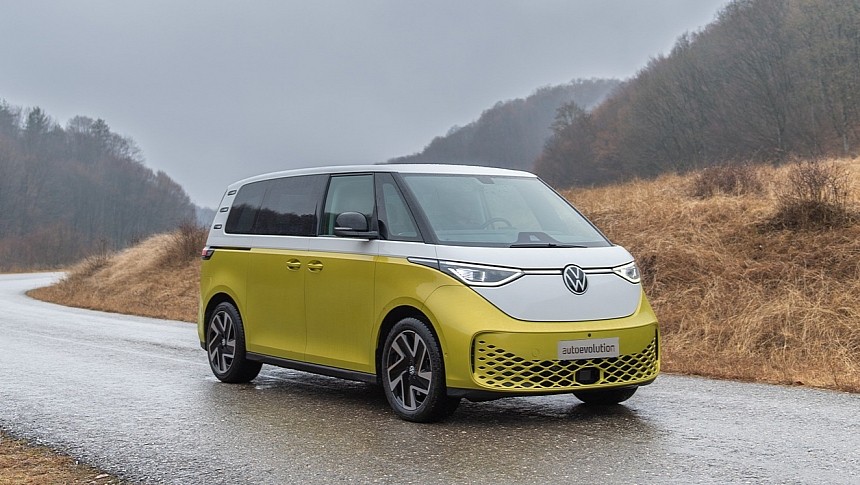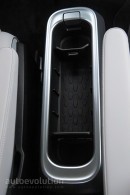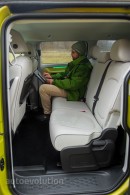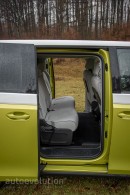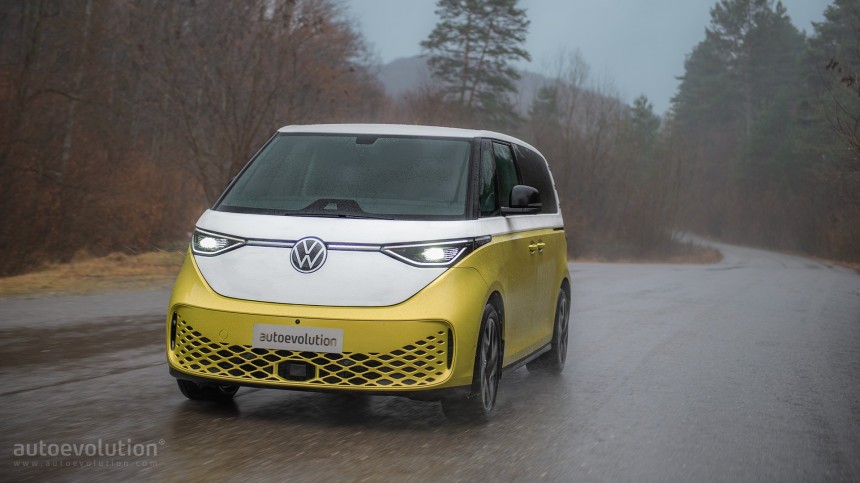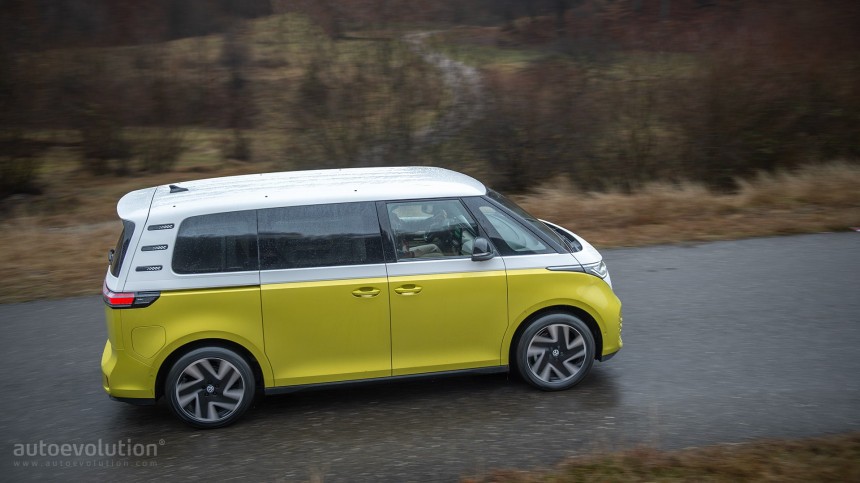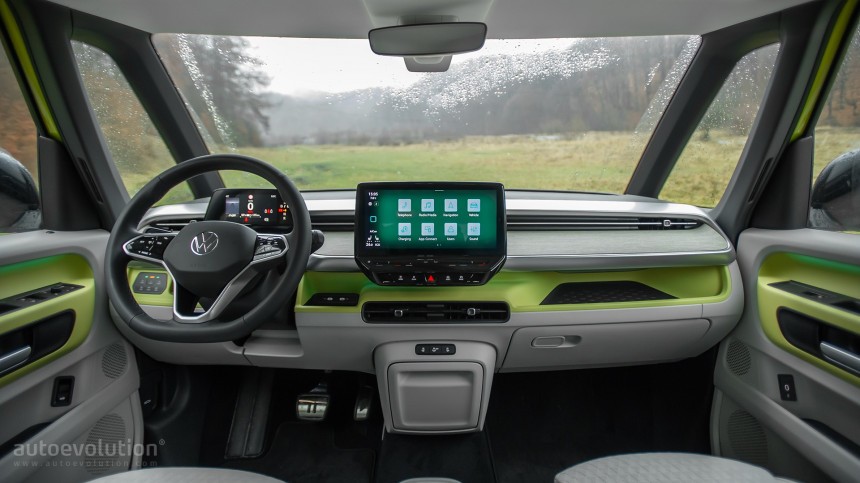To people who weren't around about 60 years ago, the appearance of the Volkswagen ID.Buzz is probably that of a quirky minivan that looks modern enough to be firmly part of a 21st-century world.
It's also a nod, both stylistically and culturally, to the Volkswagen T1, also known officially or unofficially, depending on the market, as the Type 2, Transporter, Kombi, or Microbus. Somewhat more informally, it
was also known as the Volkswagen Bus in the United States, the Camper in the UK, or the Bulli in its home country of Deutschland.
The higher-ups at Vee-Dub would prefer everyone to think that the ID.Buzz is simply the modern incarnation of the legendary Type 2. In reality, you couldn't be further from the truth, or so I thought before we embarked on testing the electric minivan. Even the model's product manager called it 'modern and fresh and exciting for folks who may not have been around [during the 1960s and ‘70s].'
The fun part is that Volkswagen isn't wrong because during our limited time with the ID.Buzz, it was like traveling on the back of a dancing bear shooting fireworks, with every single bystander giving us more
stares than they would to a widebody Lamborghini.
A lot of attention was given to the optional two-tone paint, but I'm pretty sure that the gist of it was thanks to the downright lovable exterior design, albeit we did find a few people absolutely hating its
'stormtrooper helmet' front-end styling.
With that in mind, a set of round or oval headlights, instead of those slim, hungry-looking LED headlamps, would have probably worked wonders to turn the haters around.
That said, the ID.Buzz is only harking back to the Type 2 as far as design goes because those who know their Hippie vans remember that part of the original model's appeal was its Cab Over Engine (COE) front
end, which freed up a lot of space behind the front passengers while also drastically increasing their chance of injury during a frontal impact. Used either as a workhorse, vacation vehicle, or an actual house on wheels during the Hippie era, the original Bus is every bit of an icon of the automotive industry as the Porsche 911 or the Chevrolet Corvette.
Initially derived from the floorplan of the rear-engined Type 1, also known as the Beetle, the VW Type 2 is one of the two cars used as building blocks for what Volkswagen is today, one of the largest car
manufacturers on the planet.
The last versions of the Type 2 were built in 2013 in Brazil, thus marking the end of the rear-engined Volkswagens era after 64 years, at least until the current ID range of EVs was developed, which also uses rear motors and rear-wheel-drive in their standard versions. This brings us to the ID.Buzz, based on a slightly modified version of the battery-electric MEB platform, which every single ID. model in the Volkswagen lineup uses.
In other words, even though it isn't powered by a tiny flat-four engine, it doesn't have rounded headlights or a cab-over design, the ID.Buzz is still very much reminiscent of the original idea behind the Type 2. I am talking about a charming people carrier looking to the past while having one foot firmly in the future, as it's Volkswagen's first production zero-emission minivan.
The model was initially launched in two versions, one called the ID.Buzz Cargo, with three seats and more space for hauling stuff in the back and one for carrying up to 5 passengers and quite a bit of luggage.
Only available with a rear motor and RWD, Volkswagen is also preparing a longer version with an extra motor for the front axle, making it all-wheel-drive and worthy enough to be sold on the American market. We tested the passenger version in its 201-horsepower, rear-wheel-drive, five-seat iteration, meaning our expectations were set low from the start.
Nobody would expect excellent driving dynamics or even a hint of sportiness from what is essentially a van with only 201 HP (204 PS) to move over 2.5 metric tons in a driver-pleasing manner. As it turns out, I was partly wrong, mostly thanks to a few technicalities.
The permanent magnet brushless motor only has 230 lb-ft (310 Nm) of torque, but all that oomph is available from zero RPM, like in all EVs, meaning that at lower and medium speeds, you really get pushed into your seat when flooring it.
The ID.Buzz is one of the most aerodynamic minivans on sale today, with a drag coefficient of only 0.29. That said, having only one forward gear and the weight of a fully loaded G-Wagen means that at higher speeds, it will struggle to keep its velocity gains when you push the 'go fast' pedal.
In fact, we measured its 0-60 mph (97 kph) acceleration, and the model can go twice as fast from 0 to 30 mph (50 kph) than it can go from 30 to 60 mph (97 kph). On top of it, the ID.Buzz has a top speed of 145 kph (90 mph), so don't think of it as an autobahn stormer.
With that in mind, its gigantic 3-meter wheelbase and wide front and rear tracks translate into a surprisingly stable vehicle, especially for its size and weight. It's no go-kart, but the ID-Buzz outhandles its expectations, and apart from the high driving position, there isn't much to make you think you're driving a van.
Practicality-wise, it doesn't shake a stick at the Volkswagen T7, the nephew of the Type 2, but it's more practical and spacious than a similarly sized SUV. This is probably why every other ID.Buzz review out there is comparing this electric minivan to an SUV, an entirely different type of vehicle.
There are three different ways to operate the (optional) electrically sliding rear doors, which offer at least 50 percent of the total practicality of the car in the city, where you will probably spend most of the time
with the quirky minivan.
Another city-driving selling point of the model is the rather small turning circle, which is almost identical to that of a compact hatchback like the VW Golf, making the ID.Buzz an almost perfect vehicle for urban
errands, like taking your kids to school.
Unfortunately, what makes this modern hippie van so great in the confined rules of a metropolitan area is also what makes it impractical outside the city and completely unlike the original Volkswagen Type 2.
Sure, it has zero emissions, and it's punchy at low city speeds because it's electric, but because it's electric, it depends on things like 'state of charge' and 'charging infrastructure' and even 'weather’ to
function like an all-around vacation vehicle. These are all things that made no difference to the original VW Bus' attitude regarding long trips with a vehicle that could hold an entire family, their luggage, and their pets.
I experienced this huge downside of the ID.Buzz by packing it with people and gear and taking it to the mountains in the middle of winter. We didn't remain strained in the middle of nowhere, but the car was out of its comfort zone, and then, so were we.
The 82-kWh battery only frees 77 kWh for the model, which normally translates to a WLTP range of 410-423 km (255 – 263 miles). During our trip to the mountains, our test drive consisted of a lot of country roads and expressways, freezing rain, and low temperatures, which gave the car a range of almost 300 km (186 miles).
Not great, not terrible, some might say, but if you live somewhere with a low count of public chargers, this version of the ID.Buzz kind of puts a leash on how far you can travel without planning your trips like Christopher Columbus or a mathematician.
The car has the interior space, the aerodynamics, and the handling of a long-distance family cruiser, but its means of propulsion relegates it to a completely different breed of vehicle than is best suited to the city, not for the outdoors, like its informal predecessors from the '60s and '70s.
Another point that kind of restricts its long drive capabilities, apart from the otherwise OK range, is the fact that its rear passengers will torment the driver on any trip that takes longer than they can handle.
Why? Well, let's just say that once you're in your seat, there is simply nothing you can do for fun back there apart from looking at your phone or out the window. The rear sliding doors have fixed windows, there is no panoramic roof, and our test car didn't have any rear entertainment system apart from a set of retractable trays on the back of the front seats. The two front seats aren't that much better either, mainly because of some of the solutions that Volkswagen somehow decided on the interiors of its ID. lineup.
The infotainment is more complicated to use than a center console filled to the brim with buttons, the giant retractable cup holder leaves little room for larger bottles, and at night you need a flashlight to locate the volume button, which isn't a button or a knob but a touch-sensitive slider underneath the center touchscreen.
Are all these downsides a deal breaker for some people? Probably, but not for all people, that's for sure. Sure, it looks like it can cover vast distances in one go, and it can't, but Volkswagen might have created
the perfect soccer mom car with the ID.Buzz.
By the time it reaches U.S. dealerships in 2024, it will have a longer version with more seats, a bigger battery, and all-wheel-drive, so expect even cooler things from the reinvented hippie bus in the future.
was also known as the Volkswagen Bus in the United States, the Camper in the UK, or the Bulli in its home country of Deutschland.
The higher-ups at Vee-Dub would prefer everyone to think that the ID.Buzz is simply the modern incarnation of the legendary Type 2. In reality, you couldn't be further from the truth, or so I thought before we embarked on testing the electric minivan. Even the model's product manager called it 'modern and fresh and exciting for folks who may not have been around [during the 1960s and ‘70s].'
The fun part is that Volkswagen isn't wrong because during our limited time with the ID.Buzz, it was like traveling on the back of a dancing bear shooting fireworks, with every single bystander giving us more
stares than they would to a widebody Lamborghini.
A lot of attention was given to the optional two-tone paint, but I'm pretty sure that the gist of it was thanks to the downright lovable exterior design, albeit we did find a few people absolutely hating its
'stormtrooper helmet' front-end styling.
With that in mind, a set of round or oval headlights, instead of those slim, hungry-looking LED headlamps, would have probably worked wonders to turn the haters around.
That said, the ID.Buzz is only harking back to the Type 2 as far as design goes because those who know their Hippie vans remember that part of the original model's appeal was its Cab Over Engine (COE) front
end, which freed up a lot of space behind the front passengers while also drastically increasing their chance of injury during a frontal impact. Used either as a workhorse, vacation vehicle, or an actual house on wheels during the Hippie era, the original Bus is every bit of an icon of the automotive industry as the Porsche 911 or the Chevrolet Corvette.
Initially derived from the floorplan of the rear-engined Type 1, also known as the Beetle, the VW Type 2 is one of the two cars used as building blocks for what Volkswagen is today, one of the largest car
manufacturers on the planet.
The last versions of the Type 2 were built in 2013 in Brazil, thus marking the end of the rear-engined Volkswagens era after 64 years, at least until the current ID range of EVs was developed, which also uses rear motors and rear-wheel-drive in their standard versions. This brings us to the ID.Buzz, based on a slightly modified version of the battery-electric MEB platform, which every single ID. model in the Volkswagen lineup uses.
In other words, even though it isn't powered by a tiny flat-four engine, it doesn't have rounded headlights or a cab-over design, the ID.Buzz is still very much reminiscent of the original idea behind the Type 2. I am talking about a charming people carrier looking to the past while having one foot firmly in the future, as it's Volkswagen's first production zero-emission minivan.
Coolest Looking Modern VW?
Only available with a rear motor and RWD, Volkswagen is also preparing a longer version with an extra motor for the front axle, making it all-wheel-drive and worthy enough to be sold on the American market. We tested the passenger version in its 201-horsepower, rear-wheel-drive, five-seat iteration, meaning our expectations were set low from the start.
Nobody would expect excellent driving dynamics or even a hint of sportiness from what is essentially a van with only 201 HP (204 PS) to move over 2.5 metric tons in a driver-pleasing manner. As it turns out, I was partly wrong, mostly thanks to a few technicalities.
The permanent magnet brushless motor only has 230 lb-ft (310 Nm) of torque, but all that oomph is available from zero RPM, like in all EVs, meaning that at lower and medium speeds, you really get pushed into your seat when flooring it.
The ID.Buzz is one of the most aerodynamic minivans on sale today, with a drag coefficient of only 0.29. That said, having only one forward gear and the weight of a fully loaded G-Wagen means that at higher speeds, it will struggle to keep its velocity gains when you push the 'go fast' pedal.
In fact, we measured its 0-60 mph (97 kph) acceleration, and the model can go twice as fast from 0 to 30 mph (50 kph) than it can go from 30 to 60 mph (97 kph). On top of it, the ID.Buzz has a top speed of 145 kph (90 mph), so don't think of it as an autobahn stormer.
With that in mind, its gigantic 3-meter wheelbase and wide front and rear tracks translate into a surprisingly stable vehicle, especially for its size and weight. It's no go-kart, but the ID-Buzz outhandles its expectations, and apart from the high driving position, there isn't much to make you think you're driving a van.
SUV or Minivan?
There are three different ways to operate the (optional) electrically sliding rear doors, which offer at least 50 percent of the total practicality of the car in the city, where you will probably spend most of the time
with the quirky minivan.
Another city-driving selling point of the model is the rather small turning circle, which is almost identical to that of a compact hatchback like the VW Golf, making the ID.Buzz an almost perfect vehicle for urban
errands, like taking your kids to school.
Unfortunately, what makes this modern hippie van so great in the confined rules of a metropolitan area is also what makes it impractical outside the city and completely unlike the original Volkswagen Type 2.
Sure, it has zero emissions, and it's punchy at low city speeds because it's electric, but because it's electric, it depends on things like 'state of charge' and 'charging infrastructure' and even 'weather’ to
function like an all-around vacation vehicle. These are all things that made no difference to the original VW Bus' attitude regarding long trips with a vehicle that could hold an entire family, their luggage, and their pets.
I experienced this huge downside of the ID.Buzz by packing it with people and gear and taking it to the mountains in the middle of winter. We didn't remain strained in the middle of nowhere, but the car was out of its comfort zone, and then, so were we.
The 82-kWh battery only frees 77 kWh for the model, which normally translates to a WLTP range of 410-423 km (255 – 263 miles). During our trip to the mountains, our test drive consisted of a lot of country roads and expressways, freezing rain, and low temperatures, which gave the car a range of almost 300 km (186 miles).
Not great, not terrible, some might say, but if you live somewhere with a low count of public chargers, this version of the ID.Buzz kind of puts a leash on how far you can travel without planning your trips like Christopher Columbus or a mathematician.
Definitely Worth a Drive
Another point that kind of restricts its long drive capabilities, apart from the otherwise OK range, is the fact that its rear passengers will torment the driver on any trip that takes longer than they can handle.
Why? Well, let's just say that once you're in your seat, there is simply nothing you can do for fun back there apart from looking at your phone or out the window. The rear sliding doors have fixed windows, there is no panoramic roof, and our test car didn't have any rear entertainment system apart from a set of retractable trays on the back of the front seats. The two front seats aren't that much better either, mainly because of some of the solutions that Volkswagen somehow decided on the interiors of its ID. lineup.
The infotainment is more complicated to use than a center console filled to the brim with buttons, the giant retractable cup holder leaves little room for larger bottles, and at night you need a flashlight to locate the volume button, which isn't a button or a knob but a touch-sensitive slider underneath the center touchscreen.
Are all these downsides a deal breaker for some people? Probably, but not for all people, that's for sure. Sure, it looks like it can cover vast distances in one go, and it can't, but Volkswagen might have created
the perfect soccer mom car with the ID.Buzz.
By the time it reaches U.S. dealerships in 2024, it will have a longer version with more seats, a bigger battery, and all-wheel-drive, so expect even cooler things from the reinvented hippie bus in the future.
